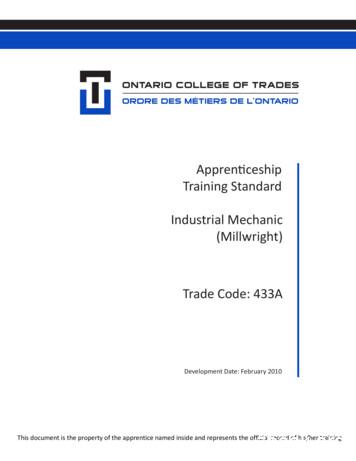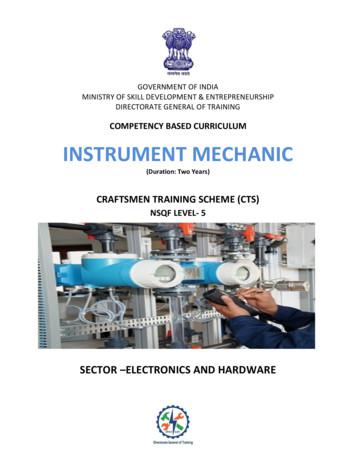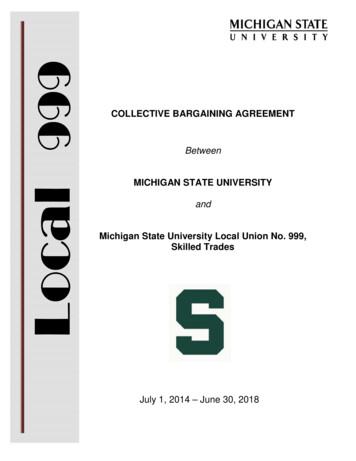Industrial Maintenance Mechanic - Urban Institute
COMPETENCY-BASED OCCUPATIONAL FRAMEWORK FORREGISTERED APPRENTICESHIPIndustrial Maintenance MechanicONET Code: 49.9041.00RAPIDS Code: 0308CBCreated: August 2018Updated:This project has been funded, either wholly or in part, with Federal funds from the Department of Labor,Employment and Training Administration under Contract Number DOL-ETA-15-C-0087. The contents of thispublication do not necessarily reflect the views or policies of the Department of Labor, nor does mention of tradenames, commercial products, or organizations imply endorsement of the same by the U.S. Government.For More Information, Contact:Diana Elliott, Senior Research Associate, Urban Institute: delliott@urban.orgRobert Lerman, PhD, Institute Fellow, Urban Institute: rlerman@urban.org
AB O U T T HE U R BA N I NS T I T U TEThe nonprofit Urban Institute is dedicated to elevating the debate on social and economic policy. For nearly fivedecades, Urban scholars have conducted research and offered evidence-based solutions that improve lives andstrengthen communities across a rapidly urbanizing world. Their objective research helps expand opportunities forall, reduce hardship among the most vulnerable, and strengthen the effectiveness of the public sector.ACKNOWLEDGEMENTSWe would like to thank several contributors for this framework. First, we would like to thank theNational Institute for Metalworking Skills (NIMS) who helped to initially develop this framework andwithout whom we would not have been able to do this work. Specifically, we would like to thankCatherine Ross and Montez King who have been critical in the development of this framework. Wewould also like to thank Tracy DiFilippis from Goodwill Southern California and Jeffrey Forrest fromCollege of the Canyons for helping to facilitate the roundtable discussion with their organization,Strong Workforce Apprenticeship Group (SWAG), to vet this framework.We would also like to thank several people who have contributed to the development and vetting ofthis framework. They include: Jose Anaya; Jimmy Crook from the Wonderful Company; DavidGoodreau from SMA; Marybeth Jacobsen from WEC; Heather Lee O’Connell from Schaer Grinder;Greg Poteat from CACT; George Simonoff from the Wonderful Company; Jack Tobin; and Otto Vegafrom Hass.IIACKNOWLEDGMENTS
ContentsACKNOWLEDGEMENTSiiCompetency-Based Occupational Frameworks1Components of the Competency-Based Occupational Framework2Using the Competency-Based Occupational Framework to Develop a Registered ApprenticeshipProgram3Industrial Maintenance Mechanic Occupational Overview5Occupational Purpose and Context5Apprenticeship Prerequisites6Occupational Pathways6Certifications, Licensure and Other Credential Requirements6Job Functions7Stackable Programs7Options and Specializations8Levels8Work Process Schedule9Related Technical Instruction Plan9Cross-Cutting Competencies16Detailed Job Functions18JOB FUNCTION 1: Operates in the workplace in a safe and effective manner18JOB FUNCTION 2: Monitors, troubleshoots, installs, and repairs basic mechanical systems22JOB FUNCTION 3: Monitors, troubleshoots, installs, and repairs basic hydraulic systems29JOB FUNCTION 4: Monitors, troubleshoots, installs, and repairs basic pneumatic systems36JOB FUNCTION 5: Monitors, troubleshoots, and repairs electrical systems41JOB FUNCTION 6: Monitors, troubleshoots, installs, and repairs electronic and process controlsystems48JOB FUNCTION 7: Performs maintenance welding to manufacture or repair parts, equipment andother materials52JOB FUNCTION 8: Installs, removes, repairs, and replaces piping systems56Statement of IndependenceCONTENTS59III
Competency-Based OccupationalFrameworksThe Urban Institute, under contract by the U.S. Department of Labor, has worked with employers,subject matter experts, labor unions, trade associations, credentialing organizations and academics todevelop Competency-Based Occupational Frameworks (CBOF) for Registered Apprenticeshipprograms. These frameworks defined the purpose of an occupation, the job functions that are carriedout to fulfill that purpose, the competencies that enable the apprentice to execute those job functionswell, and the performance criteria that define the specific knowledge, skills and personal attributesassociated with high performance in the workplace. This organizational hierarchy – Job Purpose – JobFunctions – Competencies – Performance Criteria – is designed to illustrate that performing work wellrequires more than just acquiring discrete knowledge elements or developing a series of manual skills.To perform a job well, the employee must be able to assimilate knowledge and skills learned in varioussettings, recall and apply that information to the present situation, and carry out work activities usingsound professional judgement, demonstrating an appropriate attitude or disposition, and achieving alevel of speed and accuracy necessary to meet the employer’s business need.The table below compares the terminology of Functional Analysis with that of traditional OccupationalTask Analysis to illustrate the important similarities and differences. While both identify the keytechnical elements of an occupation, Functional Analysis includes the identification of behaviors,attributes and characteristics of workers necessary to meet an employer’s expectations.Framework TerminologyTraditional Task Analysis TerminologyJob Function – the work activities that arecarried out to fulfill the job purposeJob Duties – roles and responsibilities associatedwith an occupationCompetency – the actions an individual takesand the attitudes he/she displays to completethose activitiesTask – a unit of work or set of activities neededto produce some resultPerformance Criteria – the specific knowledge,skills, dispositions, attributes, speed andaccuracy associated with meeting the employer’sexpectationsSub Task – the independent actions taken toperform a unit of work or a work activityAlthough designed for use in competency-based apprenticeship, these Competency-BasedOccupational Frameworks also support time-based apprenticeship by defining more clearly andprecisely apprentice is expected to learn and do during the allocated time-period.COMPETENCY-BASED OCCUPATIONAL FRAMEWORKS1
CBOFs are comprehensive in to encompass the full range of jobs that may be performed by individualsin the same occupation. As employers or sponsors develop their individual apprenticeship programs,they can extract from or add to the framework to meet their unique organizational needs.Components of the Competency-Based Occupational FrameworkOccupational Overview: This section of the framework provides a description of the occupationincluding its purpose, the setting in which the job is performed and unique features of the occupation.Work Process Schedule: This section includes the job functions and competencies that would likely beincluded in an apprenticeship sponsor’s application for registration. These frameworks provide a pointof reference that has already been vetted by industry leaders so sponsors can develop new programsknowing that they will meet or exceed the consensus expectations of peers. Sponsors maintain theability to customize their programs to meet their unique needs, but omission of a significant number ofjob functions or competencies should raise questions about whether or not the program has correctlyidentified the occupation of interest.Cross-cutting Competencies: These competencies are common among all workers, and focus on theunderlying knowledge, attitudes, personal attributes and interpersonal skills that are importantregardless of the occupation. That said, while these competencies are important to all occupations, therelative importance of some versus is others may change from one occupation to the next. Theserelative differences are illustrated in this part of the CBOF and can be used to design preapprenticeship programs or design effective screening tools when recruiting apprentices to theprogram.Detailed Job Function Analysis: This portion of the framework includes considerable detail and isdesigned to support curriculum designers and trainers in developing and administering the program.There is considerable detail in this section, which may be confusing to those seeking a more succinct,higher-level view of the program. For this reason, we recommend that the Work Process Schedule bethe focus of program planning activities, leaving the detailed job function analysis sections toinstructional designers as they engage in their development work.a.Related Technical Instruction: Under each job function appears a list of foundationalknowledge, skills, tools and technologies that would likely be taught in the classroom toenable the apprentice’s on-the-job training safety and success.2COMPETENCY-BASED OCCUPATIONAL FRAMEWORKS
b.Performance Criteria: Under each competency, we provide recommended performancecriteria that could be used to differentiate between minimally, moderately and highlycompetent apprentices. These performance criteria are generally skills-based rather thanknowledge-based, but may also include dispositional and behavioral competencies.Using the Competency-Based Occupational Framework to Develop a RegisteredApprenticeship ProgramWhen developing a registered apprenticeship program, the Work Process Schedule included in thisCBOF provides an overview of the job functions and competencies an expert peer group deemed to beimportant to this occupation. The Work Process Schedule in this document can be used directly, ormodified and used to describe your program content and design as part of your registration application.The more detailed job function analysis sections of the framework may be shared with RelatedTechnical Instruction providers and so that they can develop or identify courses that have learningobjectives that support the foundational knowledge and skills upon which on-the-job competencies canbe built. This section can also be useful to workplace trainers and evaluators since it provides additionaldetail about the performance criteria that could be used to both instruct apprentices and assess theirlevel of competency throughout the program.COMPETENCY-BASED OCCUPATIONAL FRAMEWORKS3
Industrial Maintenance MechanicOccupational OverviewOccupational Purpose and ContextIndustrial Maintenance Mechanics work in the private sector and are critical to ensure the smooth andreliable operation of the industrial plants and equipment in their industry. They set out to maintain andrepair manufacturing equipment. They help to ensure through the work that they do, that industrialmachinery and equipment is maintained at the highest possible level, ensuring the productivity andsafety of the entire production team.Potential Job TitlesElectrical and Electronics Repairers; Commercial and Industrial Equipment Mechanics; IndustrialMachinery Mechanics; Maintenance Workers, Machinery; Maintenance and Repair Workers, General;and Installation, Maintenance, and Repair Workers.Attitudes and BehaviorsIndustrial Maintenance Mechanics should have well developed critical and autonomous thinking skillsto solve problems quickly, strong interpersonal skills including good listening skills and culturalsensitivity, the ability to identify the important details to focus on, the ability to understand theimplications of new information, the capability to problem solve and make decisions, the ability toexecute tasks in a specific order to obtain an outcome, the ability to pay attention to specifics or detailsincluding documenting them and staying focused despite distractions, the ability to combine pieces ofinformation to form general rules or conclusions, and the ability to arrange objects or actions in anorder or pattern related to a specific rule or set of rules.OCCUPATIONAL OVERVIEW5
Apprenticeship PrerequisitesSome apprenticeship programs may require apprentices to pass drug testing prior to commencing theapprenticeships. Other programs may require apprentices to possess a driver’s license.Occupational PathwaysIndustrial Maintenance Mechanics can enter a variety of high-tech jobs that include: maintaining,troubleshooting and improving complex machines and industrials systems, such as conveying systems,multi-axis machines, robotic welding arms, and hydraulic lifts.Certifications, Licensure and Other CredentialRequirementsCREDENTIALOffered ByBefore, During orAfter ApprenticeshipMaintenanceOperationsNIMSDuringBasic MechanicalSystemsNIMSDuringBasic HydraulicSystemsNIMSDuringBasic PneumaticSystemsNIMSDuringElectrical SystemsNIMSDuringElectronic ControlSystemsNIMSDuringProcess ControlSystemsNIMSDuringMaintenance WeldingNIMSDuringMaintenance PipingNIMSDuring6OCCUPATIONAL OVERVIEW
Job FunctionsJOB FUNCTIONSCore orOptional1.Operates in the workplace in a safe and effective mannerCore2.Monitors, troubleshoots, installs, and repairs basic mechanical systemsCore3.Monitors, troubleshoots, installs, and repairs basic hydraulic systemsCore4.Monitors, troubleshoots, installs, and repairs basic pneumatic systemsCore5.Monitors, troubleshoots, installs, and repairs electrical systemsCore6.Monitors, troubleshoots, installs, and repairs electronic and process controlsystemsCore7.Performs maintenance welding to manufacture or repair parts, equipment, andother materialsCore8.Installs, removes, repairs, and replace piping systemsCoreStackable ProgramsThis occupational framework is designed to link to the following additional framework(s) as part of acareer laddering pathway.Stackable ProgramsBase orHigherLevel1.BaseProgramStacks on top of2.3.4.OCCUPATIONAL OVERVIEW7
Options and SpecializationsThe following options and specializations have been identified for this occupation. The Work ProcessSchedule and individual job function outlines indicate which job functions and competencies weredeemed by industry advisors to be optional.Options and SpecializationsOptionSpecializationElectrical and Electronics RepairersCommercial and Industrial Equipment MechanicsIndustrial Machinery MechanicsMachinery Maintenance WorkersGeneral Maintenance and Repair WorkersInstallation, Maintenance, and Repair WorkersLevelsIndustry advisors have indicated that individuals in this occupation may function at different levels,based on the nature of their work, the amount of time spent in an apprenticeship, the level of skills orknowledge mastery, and the degree of independence in performing the job or guishing ter4Supervisor8AddedCompetenciesAdded TimeRequirementsOCCUPATIONAL OVERVIEW
Work Process ScheduleWORK PROCESS SCHEDULE 1O*NET-SOC Code:49.9041.00Industrial Maintenance Mechanic (ExistingTitle: Maintenance Mechanic) (AlternateTitle: Industrial Machinery Mechanic)RAPIDS Code: 0308CBJob Title:Level:Specialization:Stackable Program yes noBase Occupation Name:Company Contact:Address:Phone:Apprenticeship d HybridJOB FUNCTION 1: Operates in the workplace in a safe and effective mannerCompetenciesCore orOptionalA. Adheres to safety, health, and environmental rules andregulationsCoreB. Performs machine operation, including start-up, emergency,and normal shutdown and manual functions to effectivelyand safely meet production and maintenance requirements(with operator present)CoreC. Monitors machine operation and verifies that performancemeets production requirementsCoreRTIOJT1 See full framework for certifications and occupational pathways, cross-cutting competencies, and detailed jobfunctions at https://www.dol.gov/cgi-bin/leave-dol.asp?exiturl hips&exitTitle www.urban.org.WORK PROCESS SCHEDULE9
D. Locates, interprets, and stores machine operation andmaintenance documentationCoreE.CorePerforms planned and unscheduled machine maintenanceprocedures in accordance with a company-approvedmaintenance planJOB FUNCTION 2: Monitors, troubleshoots, installs, and repairs basic mechanical systemsCompetenciesCore orOptionalA. Adheres to mechanical power transmission safety rulesCoreB. Uses dimensional measurement tools properly to inspectdimensions of shafts and other componentsCoreC. Safely examines, troubleshoots and repairs powertransmissionCoreD. Aligns and adjusts gear drivesCoreE.Installs, aligns and adjusts a pillow block bearingCoreF.Lubricates equipment using correct lubricants and asrecommended by manufacturer's guidanceCoreG. Performs a preventive maintenance procedure for a givenmachine to extend machine life and minimize downtimeCoreH. Performs predictive maintenance on a given machine toextend machine life and minimize downtimeCoreI.Reads and interprets technical drawings of parts andassemblies with tolerances and basic GeometricDimensioning and Tolerancing (GD&T)CoreJ.Uses hand tools to inspect, adjust/tighten andassemble/disassemble equipment and support preventivemaintenance, inspection and troubleshooting activitiesCoreK. Uses hoists and other tools to safely handle and move partsand equipmentCoreL.CoreSelects and uses troubleshooting methodologies to findmalfunctions in machine systems to return the system toreliable, productive use in the shortest time possibleRTIOJTJOB FUNCTION 3: Monitors, troubleshoots, installs, and repairs basic hydraulic systemsCompetenciesCore orOptionalA. Adheres to fluid power systems safety rules whileunderstanding safety, health, and environmental rules andregulationsCoreB. Interprets basic fluid power schematics and identifiesschematic symbols, process flow and operation of thecomponents and systemsCore10RTIOJTWORK PROCESS SCHEDULE
C. Starts up and shuts down a hydraulic system and adjustssystem pressure using a fixed displacement pumpCoreD. Adjusts hydraulic actuator speed using a flow control valveCoreE.Services a hydraulic filter to maximize hydraulic fluidcleanlinessCoreF.Adds, changes and properly disposes of waste hydraulic fluidCoreG. Installs hydraulic conductorsCoreH. Installs and tests components in a basic hydraulic circuitCoreI.CoreTroubleshoots a basic hydraulic circuit or rotary actuatorcircuitJOB FUNCTION 4: Monitors, troubleshoots, installs, and repairs basic pneumatic systemsCompetenciesCore orOptionalA. Adheres to fluid power systems safety rulesCoreB. Adjusts pneumatic system branch and actuator speedoperating pressure using a regulatorCoreC. Services a pneumatic filter through inspection, drainage, andchangesCoreD. Services a pneumatic lubricator through inspection, fills, andadjustmentsCoreE.Installs, fills, and adjusts pneumatic conductorsCoreF.Starts up and shuts down a reciprocating air compressor andadjusts operating pressureCoreG. Installs and tests the operation of components in a basicpneumatic linear or rotary circuit given a schematicCoreH. Installs and tests components in a pneumatic circuit thatuses vacuum generators given a schematicCoreI.CoreTroubleshoots a basic pneumatic circuitRTIOJTRTIOJTJOB FUNCTION 5: Monitors, troubleshoots, and repairs electrical systemsCompetenciesCore orOptionalA. Adheres to electrical power and control systems safety rulesfor electrical power and control systemsCoreB. Interprets electrical control and power schematics to ensurethe operation of the components and systemCoreC. Adjusts limit switches and electronic sensorsCoreD. Measures voltage, current and resistance in an electricalcircuit to verify system operation and power levelsCoreWORK PROCESS SCHEDULE11
E.Selects, installs, and tests fuses and circuit breakersCoreF.Installs and tests DC electric motors in a manual controlcircuitCoreG. Installs and tests AC electric motors in a manual controlcircuitCoreH. Installs and tests electrical relay control components andcircuitsCoreI.Installs and tests electro-fluid power components andcirc
Competency-Based Occupational Frameworks 1 Components of the Competency-Based Occupational Framework 2 Using the Competency-Based Occupational Framework to Develop a Registered Apprenticeship Program 3 Industrial Maintenance Mechanic Occupational Overview 5 Occupational Purpose and Context 5 Apprenticeship Prerequisites 6 Occupational Pathways 6
Urban Design is only is 85; there is no application fee. Further information and application form see the UDG website www.udg.org.uk or phone 020 7250 0892 Urban Degsi n groUp Urban U Degsi n groUp UrBan DesiGn145 Winter 2018 Urban Design Group Journal ISSN 1750 712X nortH aMeriCa URBAN DESIGN GROUP URBAN DESIGN
[Type text] P. Estimating the Size and Structure of the Underground Commercial Sex Economy in Eight Major US Cities MEREDITH DANK, PHD URBAN INSTITUTE BILAL KHAN, PHD JOHN JAY COLLEGE MITCHELL DOWNEY URBAN INSTITUTE CYBELE KOTONIAS URBAN INSTITUTE DEBORAH MAYER URBAN INSTITUTE COLLEEN OWENS URBAN INSTITUTE LAURA PACIFICI URBAN INSTITUTE LILLY YU RICE UNIVERSITY C
1. Program Definition: Industrial Mechanic (Millwright) is defined as a person who: installs, troubleshoots, maintains, and repairs industrial mechanical machinery and equipment. INDUSTRIAL MECHANIC (MILLWRIGHT) is an approved apprenticeship program for the purposes of
Railroad Maintenance Mechanic - Job Description A Railroad Maintenance Mechanic is responsible for assisting in the maintenance and restoration of the Boone & Scenic Valley Railroad's historic railroad equipment, some that is over 100 years old. This position is primarily based out of the restoration shop, but will assist
COMPETENCY BASED CURRICULUM INSTRUMENT MECHANIC (Duration: Two Years) CRAFTSMEN TRAINING SCHEME (CTS) NSQF LEVEL- 5 SECTOR –ELECTRONICS AND HARDWARE . INSTRUMENT MECHANIC (Engineering Trade) (Revised in 2019) Version: 1.2 CRAFTSMEN TRAINING SCHEME (CTS) . The Instrument Mechanic trade under CTS is one of the popular coursesdelivered
36 143 Leave for Union Business 31 37 145 Military Leave – Short Tours of Duty 31 38 146 General Conditions 32 . Mechanic Auto I . Mechanic Auto II . 8 Mechanic Blacksmith II . Mechanic Electronics I . . the basis of individually signed voluntary checkoff authorization cards on forms t
1 Olive Hill, KY Mechanic 1930 Automobile 1 Owensboro, KY Car Washer 1930 Automobile 1 Owensboro, KY Mechanic 1930 Automobile 2 Owensboro, KY Mechanic 1920 Automobile 1 Owensboro, KY Tire Repairman 1930 Automobile Tire Company 1 Paducah, KY Machinist 1920 Automobile Garage 1 Paducah, KY Mechanic 1930 Automobile 1 Paducah, KY Structure Work 1920 .
The American Petroleum Institute Manual of Petroleum Measurement Standards (API MPMS) Chapter 19 details equations for estimating the average annual evaporation loss from storage tanks. These equations are based on test tank and field tank data and have been revised since initial publication for more accurate estimations. WHAT IS EVAPORATION? Evaporation is when a substance changes from the .






















